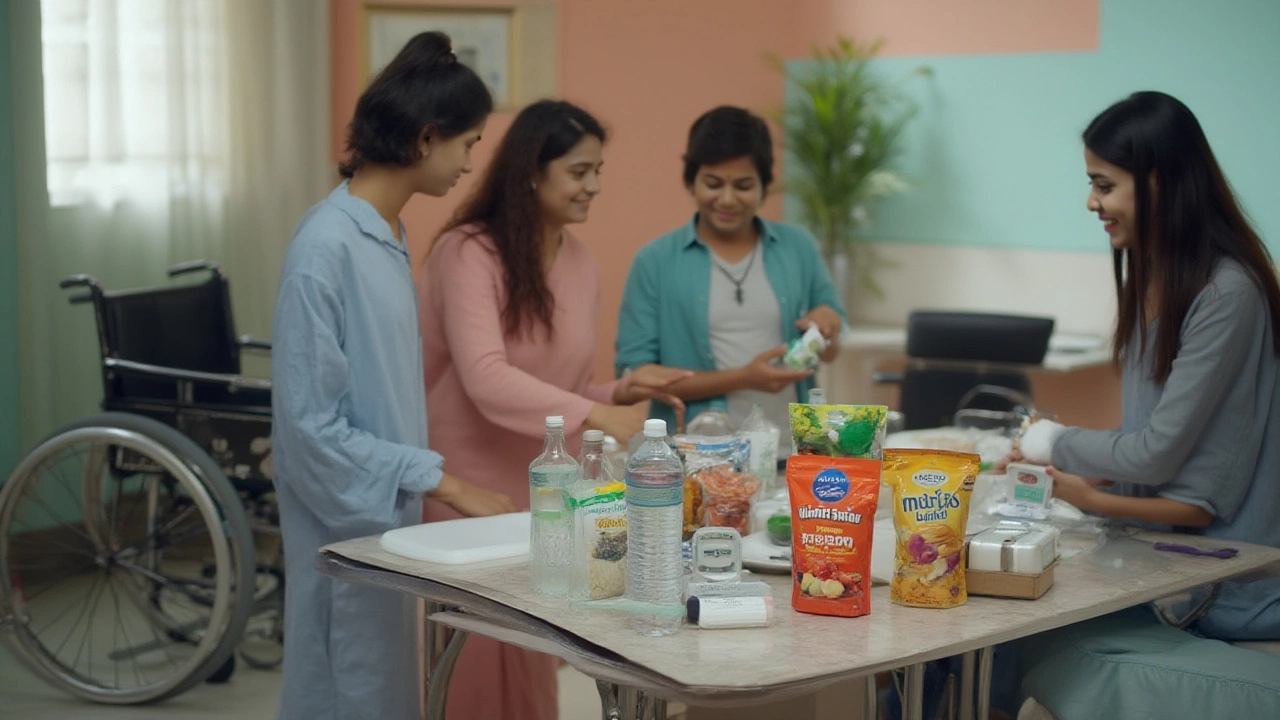What to Have Ready at Home After Open Heart Surgery: Recovery Tips and Must-Haves
 Jul, 30 2025
Jul, 30 2025
Ever tried climbing stairs with a pile of laundry right after getting stitches? Now imagine that on a chest that's just been opened for heart surgery. The little stuff—bending to tie your shoes, reaching for a glass of water, sleeping in your usual spot—suddenly feels surprisingly tough. So, what exactly does your home need for a safe, smooth recovery after open heart surgery? It's way more than just an extra pillow or two. Let’s get specific about what actually helps, what to skip, and why tiny changes make a big impact on daily life.
Building a Safe and Comfortable Environment
First thing: picture your usual routine. Anything that means stretching, stooping, or sudden movements is going to be harder for the next 6–12 weeks. Now’s your chance to play designer with a purpose. Clear clutter from walkways and keep things like rugs and cords out of traffic paths—falls are serious business when your chest is barely held together by wires and healing tissue. Consider rearranging furniture so the bed, bathroom, and kitchen are easy to access. If you have stairs, see if you can set up a temporary sleeping area on the ground floor.
Sitting up and getting into bed can turn into a surprisingly big deal after open heart surgery. Many people find a recliner works wonders for a few weeks—the angle supports the back and chest, and it’s easier to get up without straining your sternum. If a recliner isn’t possible, big, sturdy pillows or a wedge pillow can help prop up your upper body in bed, making it easier to breathe and less painful to sleep.
Keep essentials within arm’s reach. Think water, medications, tissues, phone, and some healthy snacks. An over-the-bed table, the kind hospitals use, isn’t just a medical prop—it can actually make life at home simpler, especially on groggy mornings.
When it comes to the bathroom, grab bars can be true lifesavers. You don’t have to remodel—there are tension-pole bars and sturdy suction units if you want a tool-free setup. A shower chair and a hand-held showerhead turn trips to the bathroom from intimidating to manageable. Don’t forget a non-slip mat for both inside and outside the tub—it’s a tiny detail, but slick floors are a real enemy during this time.
Lighting helps with safety, too. Place nightlights in hallways, the bathroom, and near your bed, since moving around in the dark increases risk. If you wake up for medications, bathroom visits, or just a glass of water, you’ll want to actually see what you’re doing.
Let’s talk about sleep. Many folks report they can’t lie flat for weeks, so a recliner chair or adjustable bed could mean better rest. Some people rely on noise machines to mask weird hospital sounds they got used to. Weighted blankets aren’t recommended, but a thin, light comforter or warm socks can be strangely comforting for those chilly nights.
Here’s a snapshot of common household adaptations and their benefits:
| Adaptation | Practical Benefit |
|---|---|
| Recliner or wedge pillow | Helps with breathing and minimizes chest strain when sleeping or sitting |
| Grab bars | Reduces fall risk in bathroom |
| Shower chair | Prevents slips and fatigue during bathing |
| Non-slip bathmat | Lessens risk of slip-related injuries |
| Over-bed table | Keeps items accessible without stretching |
| Nightlights | Prevents trips in dark or unfamiliar spaces |
What shouldn’t you do? Avoid lifting anything heavier than a gallon of milk (seriously, about 4–5 pounds). Lifting more than that can disrupt the delicate healing process of your chest bone, which is literally wired together after surgery. Even carrying groceries or picking up grandkids is off-limits for a while. Instead, set up your home so you barely have to carry, lift, or bend in the first place.

Stocking Up on Recovery Essentials
Pill bottles, prescription slips, post-op instruction sheets, and discharge recommendations are about to take over your kitchen table. How do you keep it from becoming a mess? Grab a pill organizer—those simple plastic boxes are worth their weight in gold if you need to take meds several times a day. Stick a list of doses and times somewhere visible—on the fridge, next to your bed, or taped to the edge of your medicine cabinet is perfect.
You’ll also want to keep track of vitals for your surgeon and cardiologist. A battery-operated blood pressure monitor is both cheap and easy to use. The American Heart Association suggests tracking both blood pressure and heart rate daily for at least two weeks after returning home. Pair it with a thermometer, because fever can mean infection during the first days of recovery.
Showers beat baths during healing because soaking can mess with the wound. Most surgeons suggest waterproof dressings at first or using cling film (yes, kitchen wrap) if you’re waiting on your first wound check. Your team will tell you when you can go back to your regular soaking routine, usually after two weeks—but for now, quick, lukewarm showers are best.
The wound itself deserves care. You’re not supposed to scrub it, pick at scabs, or put any ointment on sewn-up areas unless a doctor says so. Instead, gently clean with mild soap, pat dry, and watch for redness, swelling, or drainage that smells odd or looks cloudy—warning signs you’ll need to call your doc right away.
Your skin can itch, pull, or get dry, but using heavy creams is often a bad move on or near the incision. Stick to lotions away from the healing area, and wear loose cotton clothes—tight shirts or jackets can rub and irritate new scars. Zippered or button-up tops win, because the last thing you want is to force a T-shirt over tender skin while trying to keep your arms inside the “safe zone” (usually below shoulder height for the first 6 weeks).
Here’s what you’ll want to have before you come home:
- 7-day pill organizer
- Blood pressure cuff and digital thermometer
- Easy-open pill bottles (ask your pharmacist for non-childproof lids if dexterity is an issue)
- Alcohol-free mouthwash (dry mouth is common, but harsh stuff burns)
- Low-sodium snacks and water bottles at hand
- Sterile dressings as recommended by your surgeon
- Hand sanitizer and gentle soap for anyone helping with your care
- Comfortable, loose, front-opening clothes (think oversized flannel shirts or track jackets)
- Notebook for symptoms, questions, medication times, and daily vitals
Here’s a quick tip: put together a checklist for morning and evening routines, like brushing your teeth, taking pills, and checking your temperature. Recovery makes rambling mornings pretty common, so a list keeps you on track, and it’s helpful for caregivers or family, too. Patients who use reminders like this are 40% less likely to skip critical meds or wound care, according to a Cleveland Clinic survey.
Don’t underestimate boredom, either. Even if your brain tells you to slow down, time crawls. Puzzles, audiobooks, magazines, and even adult coloring books can help you pass the hours without needing to hold a heavy device or scroll endlessly. Noise-cancelling headphones are great for rest—hospitals love to toss around the "rest is best" mantra, but peace and quiet are hard to find at home too.
Something people overlook? Toilet paper. Having extra on hand prevents emergency dashes to the store. Same for paper towels—hand hygiene is a big deal while your wound heals. You’ll need to ask friends or family to help with shopping in the first couple weeks, so consider pre-ordering essentials before your discharge.
Transport is another thing to have sorted in advance. You’re not allowed to drive for at least 4–6 weeks (or until your surgeon says it’s okay). Either have a trusted driver on standby or schedule rides through family or local volunteer services for follow-ups and pharmacy runs. Even if you feel fine, that sternum needs time, and sudden steering wheel moves can set you back. If public transport or rideshares are your only options, try to plan routes that don’t require running to catch the bus or climbing lots of stairs.
Here’s a summary table of useful home recovery supplies and why they matter:
| Item | Reason |
|---|---|
| Pill organizer | Prevents missed or double doses of crucial meds |
| Blood pressure monitor | Tracks early complications before they get serious |
| Waterproof bandages | Keeps incision dry and protected |
| Loose, front-button clothes | Reduces pain and keeps wound clean |
| Notebook or app for tracking vitals | Gives your care team clear info at follow-ups |

Adapting Daily Life and Enlisting Help
If you hate asking for help, recovering from heart surgery is a crash course in changing your tune. The first few weeks, you’ll probably need backup. That means meal prep, rides, laundry, or just having someone around to keep company and check that you’re not skipping meds or risking infection. It can be awkward at first, but the data says people who enlist support heal faster and head back to the hospital less often.
Doctors usually want someone at home for at least the first week, especially overnight. They can spot little changes—like a low-grade fever or mild confusion—before they turn into big problems. If family or friends aren’t around, see if a neighbor or even a paid home aide can drop by daily.
Forget doing chores "your way" for now. Loading laundry machines, vacuuming, or taking out the trash twist your chest and strain healing bones. Assign these tasks to others or do them in small, controlled bursts with built-in breaks. Even grocery bags can overstress new sternal wires. Some people make a written list of chores that family can check off during visits—it makes everyone feel helpful and nothing falls through the cracks.
You’re going to have doctor’s appointments, blood work, maybe even cardiac rehab—a structured exercise and education program for post-surgery patients. Finding rehab facilities close to home, or with virtual programs, can make a huge difference. Ask your cardiologist if you’re eligible. Participants in cardiac rehab are 25% less likely to die in the 5 years after surgery, according to the Journal of the American College of Cardiology. Bonus: these programs teach you about exercise, diet, and stress, all tailored to folks with new zipper scars.
Food suddenly becomes more important, too. Heart-healthy eating isn’t just about skipping salty chips. Get friends or family to pre-portion meals, use meal delivery services, or stock up your freezer before you’re discharged. Watch for hidden sodium in packaged food—a single can of soup can pack in 800mg, nearly half your daily max. A slow cooker or multicooker means you don’t have to fuss over a hot stove for long stretches, which is good, because standing and stirring gets exhausting, fast.
Thirst is normal after surgery, but a dry mouth can make eating miserable. Suck on sugar-free candies or ice chips for comfort. Avoid straws early on—using them can create extra chest pressure. Ask your medical team for personalized advice if you have diabetes, kidney issues, or other dietary needs. Your body’s got enough going on without juggling surprise problems from snacks or drinks.
Sometimes, emotions sneak up. People recovering from heart surgery report anxiety, sadness, or even anger—not just about the event, but about being dependent, missing out at work, or feeling left behind in family life. This is normal. If blues stick around longer than a couple weeks, let your doctor know. Joining a peer support group, either in-person or online, gives you a place to vent, get tips, and hear from people who really get it. The American Heart Association’s online forums are free and active, and you’ll pick up loads of realistic advice there.
Pets? If your furry friend weighs a lot or is rambunctious, you’ll need help at first. Resist the urge to lift or wrestle them, especially big dogs or cats, because even a little jolt can set your healing back. Instead, let someone else handle walks or litter boxes for a few weeks. Little dogs or calm cats may be the best snuggle buddies—their calm presence is often a comfort and can even help lower blood pressure. Plus, studies have shown that positive social support (even from pets) increases recovery rates from heart surgery.
One more thing to remember: cough. Yes, really. Coughing and deep breathing exercises are key for keeping lungs clear after anesthesia and chest surgery. Hug a firm pillow to your chest when you cough—this ‘splinting’ method lessens pain and protects your healing sternum. Respiratory therapists and nurses usually start practicing this with you before leaving the hospital, but don’t forget to do it regularly at home.
There’s a lot to juggle, but getting your house and support lined up ahead of time will make you feel more confident and less frazzled. The reward? Faster healing, less chance of setbacks, and a shorter road back to the good stuff—whether that’s walking the block, playing with grandkids, or tackling that stack of mystery novels by the window. Always follow your care team’s instructions, and don’t be shy about asking for help or clarification. The more you prep now, the smoother life tends to be on the other side of surgery.